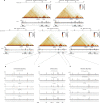In vivo dissection of a clustered-CTCF domain boundary reveals developmental principles of regulatory insulation
- PMID: 35817979
- PMCID: PMC9279147
- DOI: 10.1038/s41588-022-01117-9
In vivo dissection of a clustered-CTCF domain boundary reveals developmental principles of regulatory insulation
Abstract
Vertebrate genomes organize into topologically associating domains, delimited by boundaries that insulate regulatory elements from nontarget genes. However, how boundary function is established is not well understood. Here, we combine genome-wide analyses and transgenic mouse assays to dissect the regulatory logic of clustered-CCCTC-binding factor (CTCF) boundaries in vivo, interrogating their function at multiple levels: chromatin interactions, transcription and phenotypes. Individual CTCF binding site (CBS) deletions revealed that the characteristics of specific sites can outweigh other factors such as CBS number and orientation. Combined deletions demonstrated that CBSs cooperate redundantly and provide boundary robustness. We show that divergent CBS signatures are not strictly required for effective insulation and that chromatin loops formed by nonconvergently oriented sites could be mediated by a loop interference mechanism. Further, we observe that insulation strength constitutes a quantitative modulator of gene expression and phenotypes. Our results highlight the modular nature of boundaries and their control over developmental processes.
© 2022. The Author(s).
Conflict of interest statement
The authors declare no competing interests.
Figures
















Comment in
-
Deciphering the regulatory logic of a chromatin domain boundary.Nat Genet. 2022 Jul;54(7):914-915. doi: 10.1038/s41588-022-01086-z. Nat Genet. 2022. PMID: 35817980 No abstract available.
References
Publication types
MeSH terms
Substances
LinkOut - more resources
Full Text Sources
Other Literature Sources
Molecular Biology Databases

